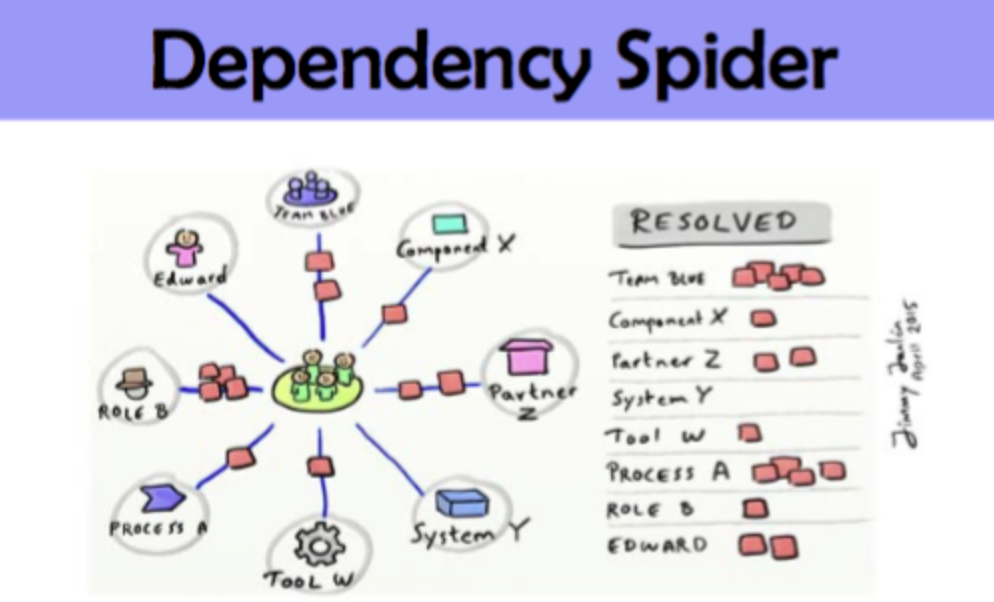Interruption buckets are my favourite tool to utilise when I want to understand where the problems are in my workflow. Interruption bucket tool provides you with the data to understand where most of your interruptions are coming from and most importantly whom from.
The great thing about interruption bucket is that due to its simple nature, it is a tool that can be used either on your own or with your team. It also provides your with metric that you can then use understand how long an interruption has lasted either yourself or your team.
No matter how well we prep as a team, most often then not you will face dependencies that you were not expecting to see. This can happen due to various reasons. One of the best ways to manage these dependencies is to create a Dependency Spider.
This is one of my absolute favourite tools to utilise at work. When we recently renovated our house I used this diagram before we started to gain an insight into our dependencies especially around blockers. By completing the tool, I was able to see how many different stakeholders I was dependent on. With the help of the tool we then able to tackle the riskiest dependencies first and develop a plan of action
Unknown dependencies
No matter how well we prep as a team, most often then not you will face dependencies that you were not expecting to see. This can happen due to various reasons. One of the best ways to manage these dependencies is to create a Dependency Spider.
This is one of my absolute favourite tools to utilise at work. When we recently renovated our house I used this diagram before we started to gain an insight into our dependencies especially around blockers. By completing the tool, I was able to see how many different stakeholders I was dependent on. With the help of the tool we then able to tackle the riskiest dependencies first and develop a plan of action.
So, what is it

You need to on a whiteboard/ Flipchart/ paper draw a black circle and label that as your team.
Around the team draw various stakeholders that the team is dependent on, make sure you don’t go overboard by having 20. I would suggest a good number is around about 8 (perfect for a spider).
Draw a line between the team and the stakeholders. On posit, notes write why as a team you are dependent on that stakeholder- try to keep it high-level.
On a weekly basis get the team around the spider dependency to understand how as a team you are going to tackle your dependency. Once, you have resolved a dependency then move it to the resolved column.
On a monthly basis review the resolved post-it notes to understand what lessons you have learnt as a team when removing that dependency.
Why
There are many tools you can use to manage your stakeholders. It becomes more difficult to get other people to understand how you need to use your stakeholders to achieve the team’s goal. By mapping out dependencies the team is then able to hone on why, how and when they need to engage with a particular stakeholder.
Wasted Time
Not everything we do adds value or contributes to our end goals. It is important that you have an understanding and awareness of where your effort is wasted. By gaining this insight you can then develop a robust approach to how you are planning to reduce the amount of your work that is wasted. Before, we continue I think it should be pointed out that no matter what you do there will always be a time when you work is wasted for various reason. This tool is to help you understand the amount of time you have wasted and who is causing this waste in your daily life.
I came across the waste snake on a blog by Anna Miedzianowska on this tool. You can find the blog here: https://productownerblog.wordpress.com/2016/04/12/waste-snake/#jp-carousel-2145
So, what is it

Draw a snake on whiteboard/flipchart paper - it needs to be visible in your daily life. Whenever you encounter an activity that you feel is wasteful, on a posit note write the following:
- What was the trigger for the activity - did someone ask you to do it
- How long did the activity take
Add the post-it note to your snake. I would suggest if you are doing this activity on your, do it for at least two weeks. This will then allow you to build some robust metrics. The same time period would be suggested if you are doing it as a team.
After two weeks:
- Categories your post-it notes - you can do it at an individual level or team level=
- Calculate the time for each category
- Place your categories in a list, to which activity took you the longest to the shortest
For each category, have 2 action points to state how you could reduce the amount of time that has been wasted within that category.
Pick two action points from your list and work on those for the next 4 weeks. Once, you have tackled those two action points you can either do another waste snake or pick more actions from your original list.
Why
It is vital in your busy life you understand the tasks that you are undertaking that do not add value to your end goals. Once, you have identified the tasks, it is vital to get analytics to understand to how much time is being wasted on these activities. I believe as human we react more to data then we do words. For example, if I said you wasted time doing a presentation for a meeting that did not take place and this cost you 6 hours in your working week. By having that 6 hours you can then calculate what else you could have done with that 6 hours.
You can do this activity either as an individual or as team. Anna talks about doing a waste snake with her team at a retrospective.
Try it
I would really recommend you try all or at least one of the above tool!
 Author: Rohela Rouf, Business Analyst
Author: Rohela Rouf, Business Analyst
My name is Rohela Raouf, I have been working as a business analyst for a few years. I have had the privilege of working across multiple programmes across the technology landscape. I am currently working in public sector helping to deliver a critical product for a large government department.
I have a passion for building services around user needs and delivering them quickly- learning from the users and iterating on the product to create a product that the users want to use.
If you have any questions, feedback- let me know via twitter- https://twitter.com/RohelaRaouf